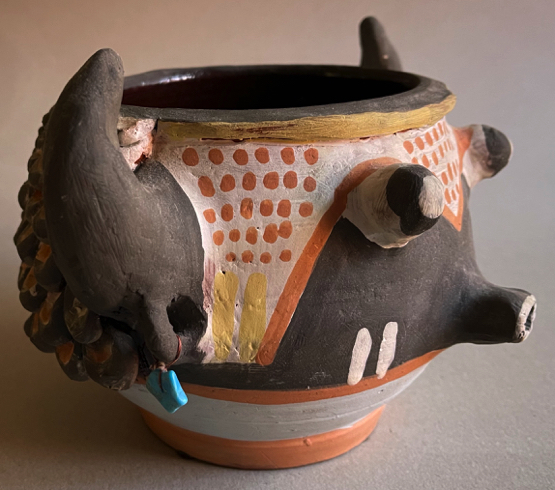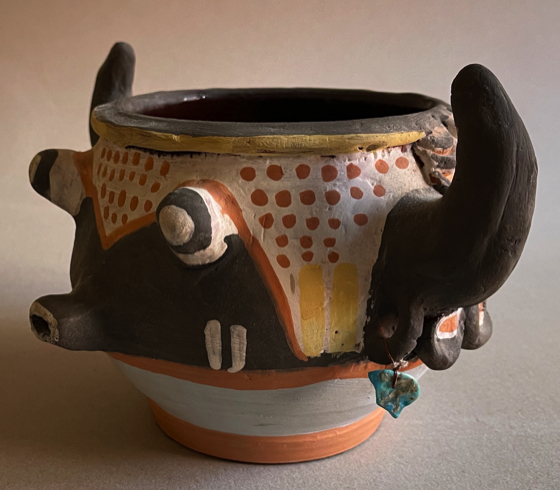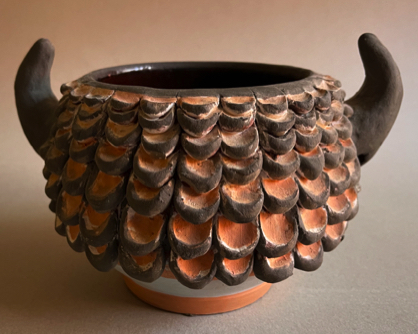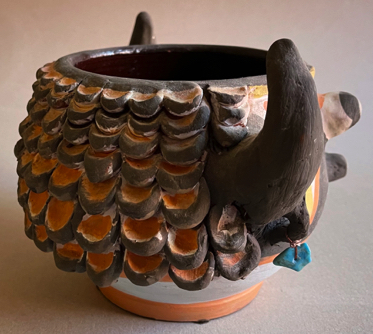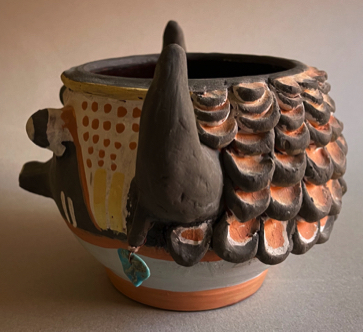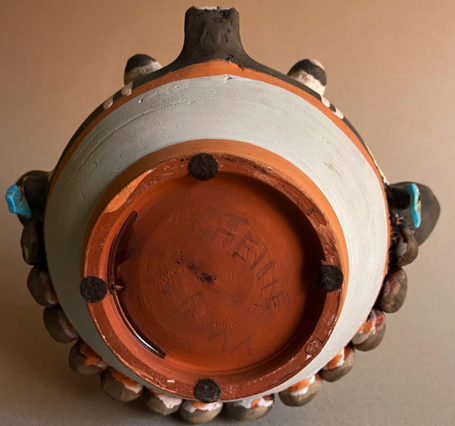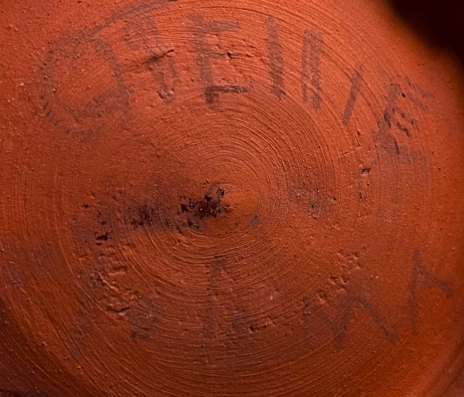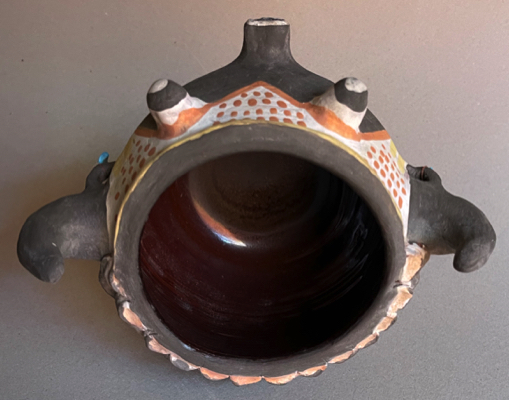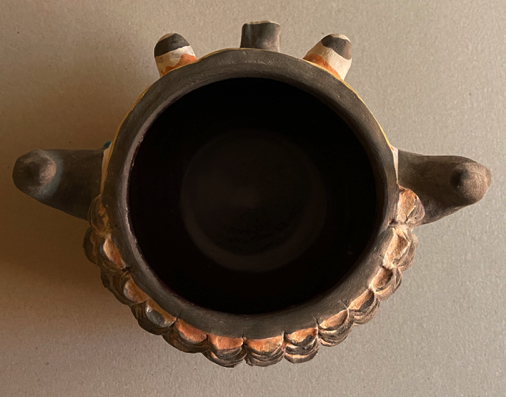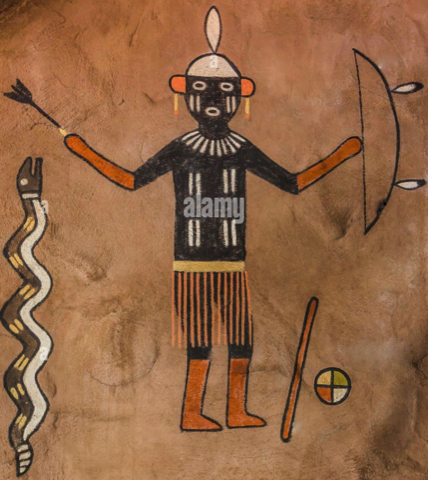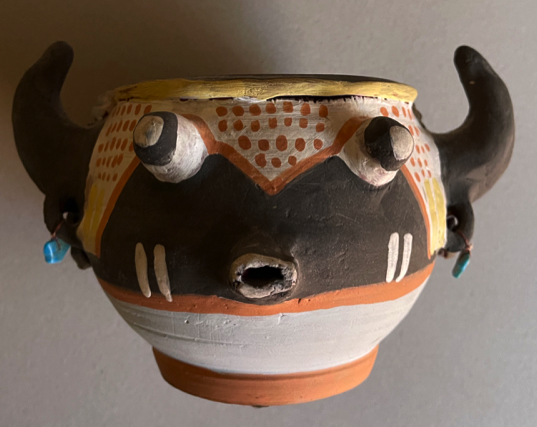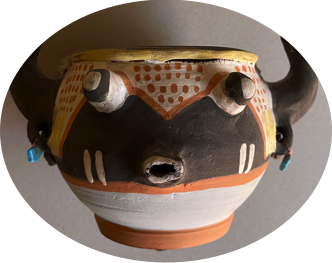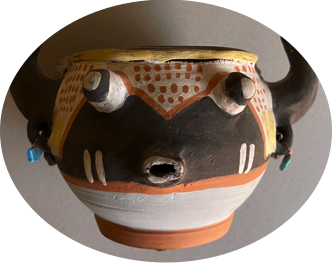
© 2010-2021 by Fine Arts of the Southwest, Inc. All rights reserved.
Unauthorized reproduction or use is strictly prohibited by law.
A Modernist Hopi kachina effigy pottery jar by
Otellie Pasiyeva Loloma, Santa Fe, NM, c.1970’s
This piece is definitely not your everyday Hopi pottery. In the early 1950’s, Hopi ceramic artist, Otellie Pasiyeva Loloma (1921-1993) working alongside her husband, Charles Loloma (1921-1991), in their small studio home at Lloyd Kiva New’s Kiva Craft Center in Scottsdale, Arizona created never before seen forms of Modernist Hopi pottery. They called their work “Lolomaware” and for the next several years turned out a wide variety of remarkably inventive and unique vessels with interesting forms and glazes, with various abstracted and stylized Hopi-themed incised and painted designs.
Their distinctive new pottery found considerable artistic acclaim and commercial success attracting important clients such as architect Frank Lloyd Wright and his wife Ogilvanna. Wright commissioned the Lolomas to make numerous pottery pieces to be put in the unique Modernist homes he was designing for his clients and he in turn introduced them to some of these clients such as Harold and Carolyn Price of Tulsa, Oklahoma who would then commission further pottery pieces directly from Charles and Otellie.
In the later years of the 1950’s under the talented tutelage of his Scottsdale neighbor, the distinguished American Modernist jeweler H. Fred Skaggs who admired Loloma’s pottery and offered to trade him jewelry-making lessons in exchange for pottery, Charles became increasingly interested in making jewelry and by the early 1960’s he stopped making pottery entirely, but Otellie never stopped.
“Otellie Loloma was both an award-winning artist—recognized for innovation in materials, technique, and design—and a teacher who helped shape generations of students at the Institute of American Indian Arts in Santa Fe.”
-Smithsonian Institution National Museum of The American Indian
Charles and Otellie Loloma in their shop at The Kiva Craft Center, Scottsdale, AZ. c. 1956
-Photo source and © “Loloma, Beauty is his Name”
by Martha H. Struever, Wheelwright Museum, Santa Fe, 2005, pp. 12
Otellie Loloma with her friend and fellow IAIA instructor,
Josephine Myers Wapp, Santa Fe, circa 1960’s
-Photo source and © Ken Williams, Jr.
Mural image of The Hopi Little Elder War God painted in the
1930’s by Hopi artist Fred Kabotie (1900-1986) at The Watchtower
at Desert View on the South Rim of the Grand Canyon.
-Photo source and © Alamy
The Lolomas moved to Santa Fe in 1962 to help their friend and colleague Lloyd Kiva New establish the Institute of American Indian Arts (IAIA) and they both took important teaching positions on the faculty from the start. Otellie thus began her formal teaching career which she would continue for most of the rest of her life until her retirement in 1988. She taught pottery-making and design at IAIA and later Native dance and she continued making pottery on her own in more limited amounts but with increasingly dazzling artistic and technical effect. Charles and Otellie divorced
in 1965 and he subsequently moved back to his home village of Hotevilla at Hopi to continue his jewelry-making career. Otellie remained in Santa Fe and always retained her married last name.
This magnificent kachina effigy jar is one of Otellie’s IAIA-period pieces, made in Santa Fe, c.1970. The form is that of
a stylized Hopi kachina mask, based loosely on the depiction of one of the Hopi’s most significant deity figures, “Pookonghoya”, or “The Little Elder War God.” The form of the piece is simply remarkable and incredibly well done;
the molding of the facial features, horns and the stylized feathers on the back of the head is superb as is the finely detailed and beautifully colored painting. In a lovely subtle touch the interior of the jar is glazed while the exterior matte-painted. A final interesting addition is the pair of tied-on turquoise chunk earrings that adorn the mask.
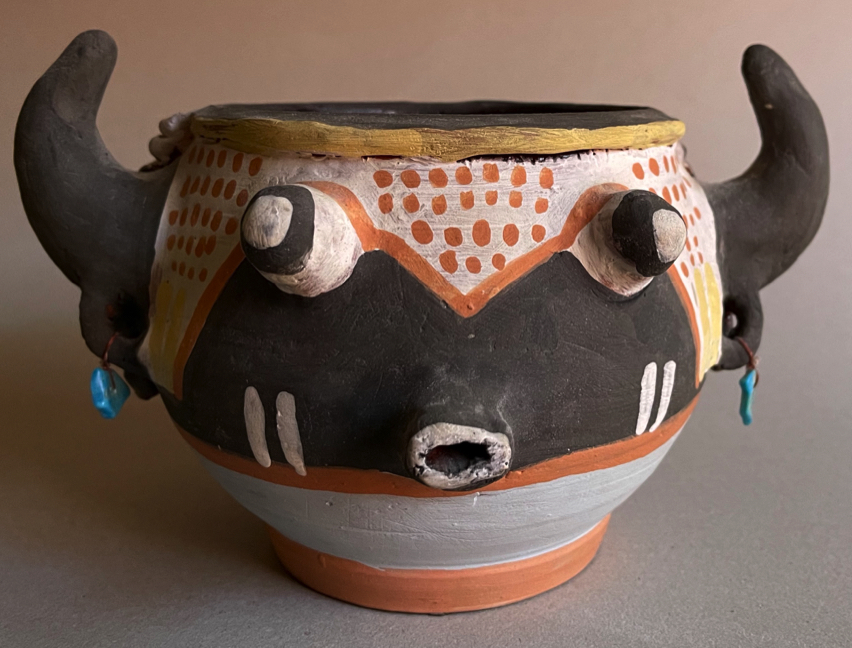
All told, it’s a modernist pottery masterwork. This is precisely why Otellie’s Pottery is included in the permanent collections of the Smithsonian’s National Museum of the American Indian, The Heard Museum, The Cooper-Hewitt Museum and The Philbrook Museum of Art, among other fine institutions. The ground-breaking uniqueness and remarkable quality of Otellie’s ceramic work and design sensibility was also an important factor influencing the later work of the young Native American artists whose work her work helped inspire; Cochiti Pueblo potter Diego Romero, Otellie’s nephew, Hopi/Navajo potter Nathan Begaye and prominent Native American painters, Hopi Dan Namingha and Navajo Tony Abeyta.
The jar measures 5 1/2” in height and is 8” in diameter at its widest point. It is in thoroughly excellent original condition and it is signed “Otellie Loloma” in very light brown paint on the bottom. It is worth noting the distinct similarity of Otellie’s rendition of her last name, “Loloma”, to Charles Loloma’s own unique “Loloma”signature on his late pottery pieces and subsequently on all of his jewelry.
This striking piece is a master work by a distinguished master artist, worthy of any collection anywhere in the world
by virtue of its sheer artistic brilliance and cultural importance.
SOLD
